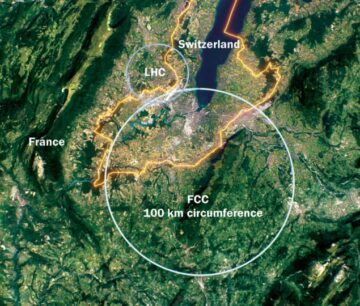
“Boffin” is a quintessentially British word that refers to a stereotypical scientist – usually portrayed as an oddball, grey-haired, white man in a lab coat. It is very popular with the UK’s tabloid press, which revels in headlines like “Boffins say don’t eat too many cakes” etc.
Earlier this year, the UK’s Institute of Physics (IOP) launched its “Bin the Boffin” campaign, saying that the term reinforces a harmful stereotype that may be preventing some people from considering careers in physics. The campaign was very successful in one sense; it was widely reported by the tabloids. Some newspapers were taken aback by the IOP’s drive and responded with headlines such as “Boffins: stop calling us boffins” (that one appeared in the Daily Star).
Now, the IOP has hit back by projecting its message onto the sides of London buildings associated with tabloids, including a skyscraper at Canary Warf that is home to the Star (see figure).
Not taken lightly
The IOP’s deputy chief executive Rachel Youngman explains, “Running around at night with projectors is not something the IOP does very often or does lightly, but we want to see the word ‘boffin’ binned once and for all”. She adds, “It’s a cliché, no-one knows quite what it means, and young people have told us it puts them off a career in physics”.
The projector campaign also targeted The Sun and Youngman says that she is keen to meet with editors from the two newspapers to talk about guidelines for reporting on physicists and physics that the IOP has drawn up.
Cast your mind back to your days as a physics undergraduate and you will recall that you used 9.8 m/s2 as the force of gravity as felt by objects on Earth. However, this value changes slightly as you move around the planet and it can vary by as much as 0.7% around the globe.
Puzzling geoid low
Gravity is particularly weak in the centre of the Indian Ocean – an effect called the Indian Ocean geoid low (IOGL). Geophysicists have long puzzled over the origins of the IOGL, but now two researchers at the Centre for Earth Sciences at the Indian Institute of Science in Bengaluru say that they have worked out why it exists.
According to the Guardian, the researchers reconstructed last 140 million years of plate tectonics in the region. Debanjan Pal and Attreyee Ghosh believe that as pieces of the oceanic plate travel under the continent of Africa, large amounts of hot and less dense material are rising in the centre of the Indian Ocean. This creates a large area of low density and therefore low gravity in the region.
The duo report their results in Geophysical Research Letters.
- SEO Powered Content & PR Distribution. Get Amplified Today.
- PlatoData.Network Vertical Generative Ai. Empower Yourself. Access Here.
- PlatoAiStream. Web3 Intelligence. Knowledge Amplified. Access Here.
- PlatoESG. Automotive / EVs, Carbon, CleanTech, Energy, Environment, Solar, Waste Management. Access Here.
- BlockOffsets. Modernizing Environmental Offset Ownership. Access Here.
- Source: https://physicsworld.com/a/bin-the-boffin-campaign-lights-up-london-why-gravity-is-weak-in-the-indian-ocean/
- :has
- :is
- :not
- $UP
- 9
- a
- About
- Adds
- africa
- also
- amounts
- an
- and
- appeared
- ARE
- AREA
- around
- AS
- associated
- At
- back
- BE
- believe
- BIN
- British
- but
- by
- called
- calling
- Campaign
- CAN
- Career
- careers
- centre
- Changes
- chief
- considering
- continent
- creates
- David
- Days
- deputy
- does
- Dont
- drawn
- drive
- earth
- Earth sciences
- eat
- effect
- etc
- executive
- exists
- Explains
- Figure
- For
- Force
- from
- globe
- gravity
- guidelines
- harmful
- Have
- Headlines
- Hit
- Home
- HOT
- However
- HTTPS
- image
- in
- Including
- Indian
- information
- Institute
- issue
- IT
- ITS
- jpg
- Keen
- lab
- large
- Last
- launched
- less
- lightly
- like
- London
- Long
- Low
- man
- many
- material
- max-width
- May..
- means
- Meet
- message
- million
- mind
- move
- much
- Newspapers
- night
- now
- objects
- ocean
- of
- off
- offices
- often
- on
- once
- ONE
- or
- out
- over
- particularly
- People
- Physics
- Physics World
- pieces
- planet
- Plate Tectonics
- plato
- Plato Data Intelligence
- PlatoData
- Popular
- press
- preventing
- Projection
- Puts
- refers
- region
- reinforces
- report
- Reported
- Reporting
- research
- researchers
- Results
- rising
- say
- saying
- says
- Science
- SCIENCES
- Scientist
- see
- sense
- she
- Sides
- skyscraper
- some
- something
- Stop
- successful
- such
- taken
- Talk
- targeted
- term
- that
- The
- their
- Them
- therefore
- they
- this
- this year
- thumbnail
- to
- too
- travel
- true
- two
- under
- us
- used
- usually
- value
- very
- want
- was
- we
- were
- What
- which
- white
- why
- widely
- will
- with
- Word
- worked
- world
- year
- years
- You
- young
- Your
- zephyrnet













